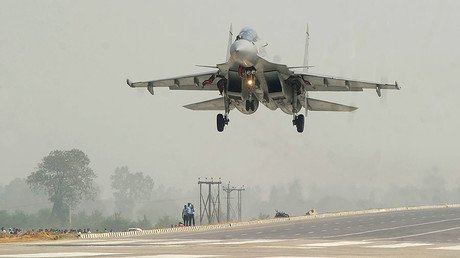Trump’s Iran decision could kill the OPEC+ deal

Trump’s decision to let Iran waivers expire could kill off the OPEC+ deal while dealing a serious blow to the coalition’s ability to coordinate production cuts.
The Wall Street Journal reported that the Trump administration’s decision to let waivers expire “surprised buyers and others who had been told by State Department officials in recent weeks to expect a renewal of exceptions.”
The White House said that Saudi Arabia and the UAE have agreed to offset lost barrels from Iran, although Saudi Arabia was more measured in its response, saying only that it would add supply if needed. In theory, Saudi Arabia could add a few hundred thousand barrels per day above current levels and still keep output below its ceiling as part of the OPEC+ deal, but that may not be enough to compensate for outages in Iran, which could be significant. After all, the whole point of the US campaign is to take Iranian oil exports to zero, down from roughly 1.3 million barrels per day (mb/d) in March.
Also on rt.com United States to end sanction waivers for countries importing Iranian oil“Saudi Arabia is currently producing approx. 500,000 barrels per day less than stipulated in the production cut agreement. Saudi Arabia could increase its output by this amount without any problem,” Commerzbank said in a note. “Any more pronounced rise would violate the agreement and could spark considerable turmoil within OPEC. It remains to be seen whether Saudi Arabia will be prepared to do this.”
If Saudi Arabia went beyond its ceiling, it would likely fatally wound the OPEC+ deal, so it’s unlikely that they would do this without consulting with OPEC+. Regardless, the optics of Saudi Arabia coordinating with the US could immediately undermine the OPEC+ group. Saudi oil minister Khalid al-Falih went to lengths to try to assuage the concerns of the group, stating that Saudi Arabia would “coordinate with fellow oil producers to ensure adequate supplies are available to consumers while ensuring the global oil market does not go out of balance.”
Read more on Oilprice.com: Why the Argentinian shale boom isn’t taking off
That likely means that Saudi Arabia won’t act unilaterally and won’t act preemptively. Having been burned last year by the Trump administration, Riyadh will surely wait until actual barrels are knocked offline before it opens the taps. And any supply increase would likely come under the auspices of coordinated action as part of the OPEC+ forum. Saudi Arabia could add some supply over the next month or two ahead of the June meeting in Vienna, but any increase will probably be small and still in compliance with the agreement.
Riyadh is trying to pull of a difficult balancing act. “Saudi Arabia is now in a difficult position of having an alliance with Russia to reduce oil supplies and having an alliance with the US to increase supplies,” Oliver Jakob, head of PetroMatrix GmbH, told Bloomberg. “You can’t have it both ways for too long.”
Also on rt.com Saudi Arabia to 'stabilize' oil market after US ends sanction waivers on Iranian crude – RiyadhAlready, cohesion was showing signs of fraying. Russia has previously said that it would not sign on to overly tightening the market. News that Saudi Arabia may work with the Trump administration, whether that interpretation is fair or not, could undermine willingness to keep curtailments in place.
“Russia’s willingness to cut in order to support the oil price probably vanishes around $65,” Bjarne Schieldrop, chief commodities analyst at SEB, said in a statement. Schieldrop says that Russia will probably boost production in the second half of the year.
If the Saudis are seen as going too far to work with the American government, the rest of OPEC+ may abandon the deal, although because so many producers are in pretty bad shape and can’t increase output, it’s not clear what that means in practice.
Read more on Oilprice.com: Can Saudi Arabia still sway the oil market?
At the same time, Saudi Arabia is still under pressure from Washington to head off a painful price spike.
Trump has one card left to play as leverage over Saudi Arabia. The US Congress has demonstrated some semblance of bipartisan support for the NOPEC legislation, a bill that would remove sovereign immunity from OPEC members as it relates to antitrust action. If passed, the Justice Department could, in theory, sue those countries for colluding to manipulate oil prices. Saudi Arabia has signaled its fierce opposition to the legislation, and Trump has yet to take a stance on it.
If oil prices rise too far, Trump may signal his support for the NOPEC bill, which could substantially boost its odds of becoming law. That threat alone could push Saudi Arabia into keeping prices in check. But again, Riyadh also has budgetary concerns as well as a strategic goal of keeping the OPEC+ group together. It’s a tricky balancing act.
Also on rt.com Trump’s hardline on Iran catches oil markets off-guardMeanwhile, the decision by the US government to apply maximum pressure on Iran may prevent Washington from further tightening the screws of Venezuela, for fear of tightening the oil market too much. The US may have to hold off on secondary sanctions on Venezuela due to its Iran campaign, according to Argus Media.
The decision on Iran sanctions waivers has for months been cited as one of the key variables affecting the trajectory of the oil market this year. With the decision now clear, the market is heading in a bullish direction. Now the ball is in the court of OPEC and its partners.
This article was originally published on Oilprice.com














